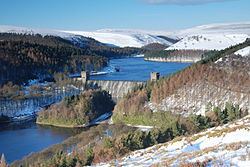Primary outflows River Derwent Outflow location River Derwent, Derbyshire | Basin countries United Kingdom Lake type Reservoir | |
 | ||
Primary inflows Inflow source River Westend, River Derwent, Derbyshire Similar Derwent Reservoir, Ladybower Reservoir, Margery Hill, Derwent Edge, Bleaklow | ||
The Howden Reservoir is a Y-shaped reservoir, top one of the three in the Upper Derwent Valley, England. The western half of the reservoir lies in Derbyshire, whereas the eastern half is in Sheffield, South Yorkshire. The county border runs through the middle of the reservoir, following the original path of the River Derwent. The longest arm is around 1.25 miles (2 km) in length. The reservoir is bounded at the southern end by Howden Dam; below this, the River Derwent flows immediately into Derwent Reservoir and subsequently the Ladybower Reservoir. Other tributaries include the River Westend, Howden Clough and Linch Clough.
Map of Howden Reservoir, Hope Valley, UK
Work commenced on the dams construction on 16 July 1901 and completed in July 1912. The works involved constructing a temporary village at Birchinlee, or "Tin Town", for the workers, a temporary railway line from the main line at Bamford, construction of a link aqueduct to the Derwent Dam. The dam is of solid masonry construction, and 117 ft tall (36 m), 1,080 ft long (330 m), and impounds 1,900,000 imperial gallons (8,600 kl) of water, from a catchment area of 5,155 acres (20.86 km2). The workers who died during the construction of the dam were buried in Bamford Church.
To the east of the reservoir stands the hill of Featherbed Moss, one of the highest tops in the area at 545 m, and one of several tops of that name in the area.
